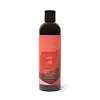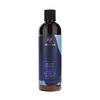What's inside
What's inside
 Key Ingredients
Key Ingredients

 Benefits
Benefits

 Concerns
Concerns

 Ingredients Side-by-side
Ingredients Side-by-side

Water
Skin ConditioningAloe Barbadensis Leaf Juice
Skin ConditioningDisodium Cocoamphodipropionate
CleansingTrideceth-7 Carboxylic Acid
CleansingDisodium Laureth Sulfosuccinate
CleansingCocamide Mipa
EmulsifyingPolysorbate 20
EmulsifyingPunica Granatum Fruit Juice
MaskingGlycerin
HumectantPassiflora Edulis Fruit Juice
Skin ConditioningHydrolyzed Lupine Protein
Skin ConditioningSerenoa Serrulata Fruit Extract
Skin ConditioningLinum Usitatissimum Seed Extract
PerfumingMelia Azadirachta Leaf Extract
Skin ConditioningGlycyrrhiza Glabra Root Extract
BleachingCamellia Sinensis Leaf Extract
AntimicrobialBetaine
HumectantRoyal Jelly
Niacinamide
SmoothingPhytosterols
Skin ConditioningCaffeine
Skin ConditioningBiotin
AntiseborrhoeicTrifolium Pratense Flower Extract
AstringentEquisetum Hyemale Extract
Skin ConditioningUrtica Dioica Extract
AstringentCola Acuminata Seed Extract
Skin ConditioningPiroctone Olamine
PreservativeHydroxypropyl Methylcellulose
Emulsion StabilisingMaltodextrin
AbsorbentPolyquaternium-7
Polyquaternium-10
Phenoxyethanol
PreservativeCaprylyl Glycol
EmollientCitric Acid
BufferingParfum
MaskingBeta Vulgaris Extract
Skin ProtectingSodium Benzoate
MaskingEthylhexylglycerin
Skin ConditioningTetrasodium EDTA
Ceteareth-60 Myristyl Glycol
EmulsifyingPolyacrylamide
Benzyl Benzoate
AntimicrobialLimonene
PerfumingLinalool
PerfumingCI 17200
Cosmetic ColorantWater, Aloe Barbadensis Leaf Juice, Disodium Cocoamphodipropionate, Trideceth-7 Carboxylic Acid, Disodium Laureth Sulfosuccinate, Cocamide Mipa, Polysorbate 20, Punica Granatum Fruit Juice, Glycerin, Passiflora Edulis Fruit Juice, Hydrolyzed Lupine Protein, Serenoa Serrulata Fruit Extract, Linum Usitatissimum Seed Extract, Melia Azadirachta Leaf Extract, Glycyrrhiza Glabra Root Extract, Camellia Sinensis Leaf Extract, Betaine, Royal Jelly, Niacinamide, Phytosterols, Caffeine, Biotin, Trifolium Pratense Flower Extract, Equisetum Hyemale Extract, Urtica Dioica Extract, Cola Acuminata Seed Extract, Piroctone Olamine, Hydroxypropyl Methylcellulose, Maltodextrin, Polyquaternium-7, Polyquaternium-10, Phenoxyethanol, Caprylyl Glycol, Citric Acid, Parfum, Beta Vulgaris Extract, Sodium Benzoate, Ethylhexylglycerin, Tetrasodium EDTA, Ceteareth-60 Myristyl Glycol, Polyacrylamide, Benzyl Benzoate, Limonene, Linalool, CI 17200
Water
Skin ConditioningLauramidopropyl Hydroxysultaine
CleansingSodium Cocoyl Isethionate
CleansingCocamide Mipa
EmulsifyingBetaine
HumectantRicinus Communis Seed Oil
MaskingSodium Isethionate
CleansingCetearyl Alcohol
EmollientSodium Chloride
MaskingPiroctone Olamine
PreservativeCeramide NP
Skin ConditioningCeramide EOP
Skin ConditioningCeramide AP
Skin ConditioningPhytosphingosine
Skin ConditioningZanthoxylum Bungeanum Pericarp Extract
Skin ConditioningPhytosterols
Skin ConditioningHydroxypropyl Bislauramide Mea
EmollientHydroxypropyl Bisstearamide Mea
Skin ConditioningMentha Piperita Oil
MaskingMelaleuca Alternifolia Leaf Oil
AntioxidantMenthol
MaskingOlea Europaea Fruit Oil
MaskingPolyglyceryl-10 Laurate
Skin ConditioningGlycol Stearate
EmollientGlyceryl Stearate
EmollientSodium Lauroyl Lactylate
EmulsifyingSodium Cocoyl Glutamate
CleansingCoconut Acid
CleansingGlycerin
HumectantPolyquaternium-7
Stearic Acid
CleansingTrisodium Dicarboxymethyl Alaninate
Hydroxypropyl Cyclodextrin
MaskingCaprylyl Glycol
EmollientEthylhexylglycerin
Skin ConditioningSodium Benzoate
MaskingPotassium Sorbate
PreservativeCitric Acid
BufferingLimonene
PerfumingWater, Lauramidopropyl Hydroxysultaine, Sodium Cocoyl Isethionate, Cocamide Mipa, Betaine, Ricinus Communis Seed Oil, Sodium Isethionate, Cetearyl Alcohol, Sodium Chloride, Piroctone Olamine, Ceramide NP, Ceramide EOP, Ceramide AP, Phytosphingosine, Zanthoxylum Bungeanum Pericarp Extract, Phytosterols, Hydroxypropyl Bislauramide Mea, Hydroxypropyl Bisstearamide Mea, Mentha Piperita Oil, Melaleuca Alternifolia Leaf Oil, Menthol, Olea Europaea Fruit Oil, Polyglyceryl-10 Laurate, Glycol Stearate, Glyceryl Stearate, Sodium Lauroyl Lactylate, Sodium Cocoyl Glutamate, Coconut Acid, Glycerin, Polyquaternium-7, Stearic Acid, Trisodium Dicarboxymethyl Alaninate, Hydroxypropyl Cyclodextrin, Caprylyl Glycol, Ethylhexylglycerin, Sodium Benzoate, Potassium Sorbate, Citric Acid, Limonene
Ingredients Explained
These ingredients are found in both products.
Ingredients higher up in an ingredient list are typically present in a larger amount.
Betaine is a common humectant (a substance that promotes retention of moisture). It's known to be gentle on the skin and can help balance hydration.
This ingredient is best for improving hydration and soothing irritated skin. Studies also show it helps even out skin tone.
Fun fact: Betaine is naturally created in the skin and body. The kind found within cosmetic products can be either plant-derived or synthetic.
Another name for betaine is trimethylglycine.
Learn more about BetaineCaprylyl Glycol is a humectant and emollient, meaning it attracts and preserves moisture.
It is a common ingredient in many products, especially those designed to hydrate skin. The primary benefits are retaining moisture, skin softening, and promoting a healthy skin barrier.
Though Caprylyl Glycol is an alcohol derived from fatty acids, it is not the kind that can dry out skin.
This ingredient is also used as a preservative to extend the life of products. It has slight antimicrobial properties.
Learn more about Caprylyl GlycolCitric Acid is an alpha hydroxy acid (AHA) naturally found in citrus fruits like oranges, lemons, and limes.
Like other AHAs, citric acid can exfoliate skin by breaking down the bonds that hold dead skin cells together. This helps reveal smoother and brighter skin underneath.
However, this exfoliating effect only happens at high concentrations (20%) which can be hard to find in cosmetic products.
Due to this, citric acid is usually included in small amounts as a pH adjuster. This helps keep products slightly more acidic and compatible with skin's natural pH.
In skincare formulas, citric acid can:
While it can provide some skin benefits, research shows lactic acid and glycolic acid are generally more effective and less irritating exfoliants.
Most citric acid used in skincare today is made by fermenting sugars (usually from molasses). This synthetic version is identical to the natural citrus form but easier to stabilize and use in formulations.
Read more about some other popular AHA's here:
Learn more about Citric AcidWe don't have a description for Cocamide Mipa yet.
Ethylhexylglycerin (we can't pronounce this either) is commonly used as a preservative and skin softener. It is derived from glyceryl.
You might see Ethylhexylglycerin often paired with other preservatives such as phenoxyethanol. Ethylhexylglycerin has been found to increase the effectiveness of these other preservatives.
Glycerin is already naturally found in your skin. It helps moisturize and protect your skin.
A study from 2016 found glycerin to be more effective as a humectant than AHAs and hyaluronic acid.
As a humectant, it helps the skin stay hydrated by pulling moisture to your skin. The low molecular weight of glycerin allows it to pull moisture into the deeper layers of your skin.
Hydrated skin improves your skin barrier; Your skin barrier helps protect against irritants and bacteria.
Glycerin has also been found to have antimicrobial and antiviral properties. Due to these properties, glycerin is often used in wound and burn treatments.
In cosmetics, glycerin is usually derived from plants such as soybean or palm. However, it can also be sourced from animals, such as tallow or animal fat.
This ingredient is organic, colorless, odorless, and non-toxic.
Glycerin is the name for this ingredient in American English. British English uses Glycerol/Glycerine.
Learn more about GlycerinLimonene is a fragrance that adds scent and taste to a formulation.
It's found in the peel oil of citrus fruits and other plants such as lavender and eucalyptus. The scent of limonene is generally described as "sweet citrus".
Limonene acts as an antioxidant, meaning it helps neutralize free radicals.
When exposed to air, oxidized limonene may sensitize the skin. Because of this, limonene is often avoided by people with sensitive skin.
The term 'fragrance' is not regulated in many countries. In many cases, it is up to the brand to define this term. For instance, many brands choose to label themselves as "fragrance-free" because they are not using synthetic fragrances. However, their products may still contain ingredients such as essential oils that are considered a fragrance.
Learn more about LimonenePhytosterols come from plants, nuts, and whole grains. These compounds have skin soothing and moisturizing properties.
Fun fact: They are similar to cholesterol and can help lower cholesterol levels.
Piroctone Olamine is used to treat fungal infections and often found in anti-dandruff shampoo.
This ingredient is particularly effective against Malassezia, the root cause of dandruff.
Piroctone olamine is water-soluble.
Learn more about Piroctone OlaminePolyquaternium-7 is a light to clear colored liquid. It is commonly found in haircare products for its film-forming and anti-static properties.
According to a manufacturer, it is a non-paraben and specially developed for negatively charged surfactant systems. This makes it a great hairstyle holder and helps to improve wet hair detangling without adding buildup.
Sodium Benzoate is a preservative. It's used in both cosmetic and food products to inhibit the growth of mold and bacteria. It is typically produced synthetically.
Both the US FDA and EU Health Committee have approved the use of sodium benzoate. In the US, levels of 0.1% (of the total product) are allowed.
Sodium benzoate works as a preservative by inhibiting the growth of bacteria inside of cells. It prevents the cell from fermenting a type of sugar using an enzyme called phosphofructokinase.
It is the salt of benzoic acid. Foods containing sodium benzoate include soda, salad dressings, condiments, fruit juices, wines, and snack foods.
Studies for using ascorbic acid and sodium benzoate in cosmetics are lacking, especially in skincare routines with multiple steps.
We always recommend speaking with a professional, such as a dermatologist, if you have any concerns.
Learn more about Sodium BenzoateWater. It's the most common cosmetic ingredient of all. You'll usually see it at the top of ingredient lists, meaning that it makes up the largest part of the product.
So why is it so popular? Water most often acts as a solvent - this means that it helps dissolve other ingredients into the formulation.
You'll also recognize water as that liquid we all need to stay alive. If you see this, drink a glass of water. Stay hydrated!
Learn more about Water